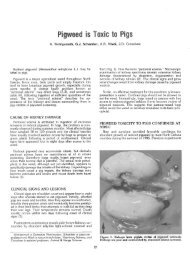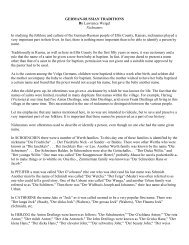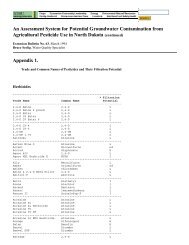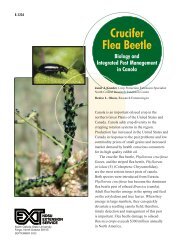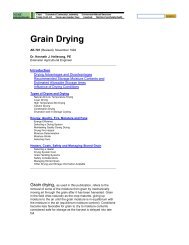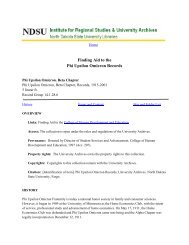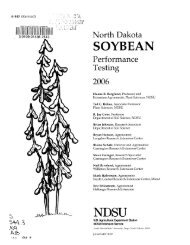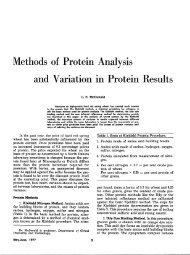germans from russia in fort collins, 1900-2000 - Libraries
germans from russia in fort collins, 1900-2000 - Libraries
germans from russia in fort collins, 1900-2000 - Libraries
You also want an ePaper? Increase the reach of your titles
YUMPU automatically turns print PDFs into web optimized ePapers that Google loves.
WORK RENDERS LIFE SWEET: GERMANS FROM RUSSIA IN FORT COLLINS<br />
November. By far the most difficult and dangerous<br />
task was pull<strong>in</strong>g and topp<strong>in</strong>g the beets<br />
for harvest. The huge beets, which often<br />
exceeded twelve pounds, were either pulled<br />
by hand or, <strong>in</strong> some cases, pulled by horses.<br />
The laborers then had to knock the clumps of<br />
soil <strong>from</strong> the beets. (The sugar companies<br />
sampled each load of beets to determ<strong>in</strong>e the<br />
average amount of soil on each one. They<br />
were not about to pay for anyth<strong>in</strong>g other than<br />
the beet itself.). Topp<strong>in</strong>g required chopp<strong>in</strong>g<br />
through the toughest, most fibrous part of the<br />
beet with a long, broad knife forged <strong>in</strong>to a<br />
hook at the end. It was a very menac<strong>in</strong>g<br />
<strong>in</strong>strument and, consider<strong>in</strong>g the force<br />
required to cut through a beet, often sliced<br />
arms and especially legs. The topped beets<br />
were then lifted <strong>in</strong>to a wagon and hauled to a<br />
beet dump on the railroad or at the factory. An<br />
average wagonload of beets weighed six<br />
tons. 73<br />
Days <strong>in</strong> the beet fields were long and<br />
tedious. Families often left their shanties or<br />
homes <strong>in</strong> Buck<strong>in</strong>gham and Andersonville<br />
long before sunrise and worked several hours<br />
before breakfast. Lunch and d<strong>in</strong>ner were<br />
taken <strong>in</strong> the fields as well. Many families<br />
retired at dusk, while some lit kerosene<br />
lanterns and cont<strong>in</strong>ued to labor at night.<br />
Temperatures dur<strong>in</strong>g the summer on the high<br />
pla<strong>in</strong>s soared, but the frigidness of fall was<br />
more brutal. The U.S. Department of Labor’s<br />
1923 report on child labor <strong>in</strong>cludes this<br />
haunt<strong>in</strong>g statement <strong>from</strong> a Colorado<br />
Hausvater:<br />
“Fall is the meanest time,” declared one<br />
of the fathers. “Women are wet up to<br />
their waists and have ice <strong>in</strong> their laps and<br />
on their underwear. Women and children<br />
have rheumatism. Jacob [thirteen years<br />
old] is big and strong but already he<br />
feels rheumatism, so he has to kneel<br />
while topp<strong>in</strong>g. Can’t stand all day.”74<br />
Amalie Klien, who spent her youth tend<strong>in</strong>g<br />
beet fields around Fort Coll<strong>in</strong>s with her family,<br />
remembered the agony of harvest:<br />
Figure 13.<br />
A German-Russian family pauses for<br />
this photograph while they harvest<br />
sugar beets by hand on a Fort Coll<strong>in</strong>sarea<br />
farm. (Courtesy, Fort Coll<strong>in</strong>s<br />
Public Library)<br />
SWCA Environmental Consultants Page 22



